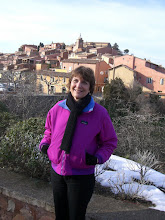
Springtime is beautiful in France. Vast fields of cérisiers (“cherry trees”) show off their puffy white blossoms. Natural scents from la glycine (“wisteria”) to le narcisse (“narcissus”) and other flowers perfume the Provençal air. What a wonderful background to the business of flowers, the well-known French perfume industry. On our recent trip to Grasse, we decided to look into one of the visites guidées gratuites (“free guided tours”) offered by the three companies still in operation in the city today: Fragonard, Galimard, or Molinard. The latter, a family-run business since 1849, appealed to us, so from the center of town, we took the free bus, called la farandole (or "conga"--we think because it has to snake around in kind of a dance) down the hill to the factory.
Our guide, Lorie, provided a lot of information, focusing on the history of the town and its perfume business. In the Middle Ages, tanneries and glove making formed the backbone of industry in Grasse. With the coming of the Italian Catherine de Médicis to the French throne in the sixteenth century, however, gloves makers searched for a way of offsetting the bad odor of the leather for members of the nobility. The idea was born of perfuming gloves, thus launching a new direction for workers in Grasse. By the time Louis XIV was in power in the 1600s, the town had become the world center of perfume manufacturing. Over the centuries, perfumers have attempted to allow for the demands of their public. In the 1920s, for example, women started cutting their hair, wearing pants, and smoking cigarettes. They desired a more masculine scent, like that of la verveine (“verbena”), as in Molinard's perfume, Habanita. These days Molinard tries to attract the young demographic with perfumes like La Souris Verte (a reference we found out to une chanson d’enfant, a children's song), which comes with a small stuffed green mouse on the top of the bottle. They also offer clients, for a fee of about 40 euros, the option to design their own fragrance.
One of the key players in the creation of perfume is le nez (literally “the nose”), the master perfumer, who often has the ability to distinguish 2000 or more scents. I was surprised to hear that very few women have this skill, given that women seem to have an acute sense of smell. Aromas can come from a variety of flowers, spices, roots, grasses, fruit, leaves, or herbs. By way of steam, solvent, or in the past enfleurage (using animal fats), according to the demands of the various sources, the essence (l’absolut) is extracted. As in the case of many fine wines, different components are then combined and the finished product must age. Lorie told us about the three notes that can be detected after applying perfume. The first whiff of it on the skin gives evidence of what is called des notes de tête (“head notes”); after about five minutes, we can sense des notes de cœur (“middle” or “heart notes”); after several hours what’s left is called des notes de fond (“base notes”). The enemies of perfume are heat, sun, and humidity which is why it should be stored with care.
The cost of perfume products depends on several factors, one being the amount of essence used. Eau de toilette contains only about 2% of essential oils, eau de cologne 4-6%, and le parfum has around 25% of l'absolut, which is why it commands such high prices. Another reason for the expense can be the container, which can account for up to 80% of the total cost. Molinard has a small museum (really several display cases) containing lovely 1930s Baccarat and Lalique crystal flacons à parfum among other items.
The entire industry in Grasse seems to have fallen on hard times. The three perfumeries that remain are no longer permitted to distill their product in the city because of pollution concerns and other perfume designers have moved on to other locales. Yet, it was interesting for us to understand the complicated process of turning flowers into perfume.




4 comments:
Fascinating explanation of perfume making in Grasse. Wish I could be there with you sniffing away. Tim has the best "sniffer" in our family and has been known to use it suspiciously on his food when I try a new dish!!!Lena
It was fun finding out about the perfume, but the actual sniffing wasn't that great...I think Tim would've been suspicious of their perfume, too!
I wanted to try to make my own perfume that can easily customize the scent and make my own signature. Anyway, creating a perfume is not a simple matter so I need a lot of knowledge,if you have any suggestion please let me know.
women pheromones
There are probably experts you could visit in some large cities to help you design your own fragrance. I would never attempt it on my own. Good luck with it.
Post a Comment